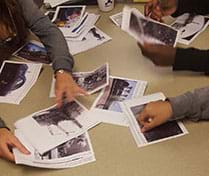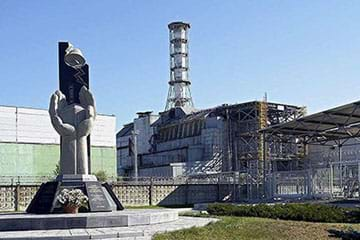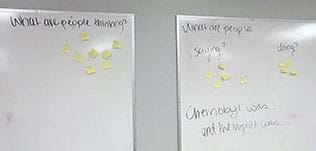Quick Look
Grade Level: 9 (8-10)
Time Required: 30 minutes
Expendable Cost/Group: US $0.00
Group Size: 4
Activity Dependency: None
Subject Areas: Earth and Space, Physics, Science and Technology

Summary
Student groups are given captioned photographs of the Chernobyl Nuclear Power Plant facility and surrounding towns taken before and 28 years after the 1986 disaster. Based on the captions and clues in the images, they arrange them in sequential order. While viewing the completed sequence of images, students reflect on what it might have been like to be there, and ask themselves: what were people thinking, doing and saying at each point? This activity assists students in gaining an understanding of how devastating nuclear meltdowns can be, which underscores the importance of responsible engineering. It is recommended that this activity be conducted before the associated lesson, Nuclear Energy through a Virtual Field Trip.Engineering Connection
Engineers design, build and oversee systems that are often highly complex. Sometimes the consequences of design or operation mistakes are costly; other times, the consequences are a matter of life and death. Responsible engineers know to make sure their designs do not result in unintended consequences that are detrimental to habitat and life. They must be vigilant in the creation of operational procedures and protocols that consider all potential scenarios to support the making of sound decisions. Nuclear and chemical engineers design and analyze the complex systems within nuclear power plants to make sure that all reactions run safely. It is important for engineers—as well as students pursuing engineering career paths—to cultivate empathy in order to remain constantly attentive to the impact of their designs and decisions on others.
Learning Objectives
After this activity, students should be able to:
- Describe the events surrounding the Chernobyl disaster.
- Describe the habitat and life impacts of the nuclear power plant accident.
- Empathize with the people affected by the disaster.
- Explain the drawbacks of nuclear-generated electricity.
Educational Standards
Each TeachEngineering lesson or activity is correlated to one or more K-12 science,
technology, engineering or math (STEM) educational standards.
All 100,000+ K-12 STEM standards covered in TeachEngineering are collected, maintained and packaged by the Achievement Standards Network (ASN),
a project of D2L (www.achievementstandards.org).
In the ASN, standards are hierarchically structured: first by source; e.g., by state; within source by type; e.g., science or mathematics;
within type by subtype, then by grade, etc.
Each TeachEngineering lesson or activity is correlated to one or more K-12 science, technology, engineering or math (STEM) educational standards.
All 100,000+ K-12 STEM standards covered in TeachEngineering are collected, maintained and packaged by the Achievement Standards Network (ASN), a project of D2L (www.achievementstandards.org).
In the ASN, standards are hierarchically structured: first by source; e.g., by state; within source by type; e.g., science or mathematics; within type by subtype, then by grade, etc.
International Technology and Engineering Educators Association - Technology
-
Students will develop an understanding of the effects of technology on the environment.
(Grades
K -
12)
More Details
Do you agree with this alignment?
State Standards
North Carolina - Science
-
Explain the consequences of human activities on the lithosphere (such as mining, deforestation, agriculture, overgrazing, urbanization, and land use) past and present.
(Grades
9 -
12)
More Details
Do you agree with this alignment?
-
Evaluate alternative energy technologies for use in North Carolina.
(Grades
9 -
12)
More Details
Do you agree with this alignment?
Materials List
Each group needs:
- a set of (23) captioned photographs of scenes around Chernobyl before and after the disaster; available at https://www.rt.com/news/155072-chernobyl-images-now-then/
- (optional) sticky notes, for concluding classroom discussion (see Assessment section)
Introduction/Motivation
In whatever jobs and careers you pursue, it is important that you consider the consequences of your work and decisions on the well-being of other people. For engineers who design new products, structures, processes and often very complex systems, it is important that they recognize the potential impacts to habitat and life of their designs, including any ongoing operational procedures. Engineers must try to think of the intended and unintended consequences of their decisions and actions, and then continually work to eliminate—or at least minimize—potential damaging impacts to the environment, species and world.
If this sounds pretty serious—it’s because it is!
Today we’re going to experience—through pictures and words—the consequences of poor facility design and faulty experimentation—in other words, human error—during the operation of a nuclear power plant. We are going to take a post-disaster tour of a nuclear power plant accident.
Be sure to look, think and feel so that you can make observations and inferences about the processes involved and the impacts caused. At the end of the activity we will draw some overall conclusions.
Procedure
Background
Empathy for the plight of others, especially when due to circumstances beyond their control is key to having an ongoing awareness and consideration of the possible consequences from the design and operation of complex systems.
We want students to understand the benefits and risks of nuclear power generation as well as the dangers involved with other methods of power generation and storage. But more important is the recognition of the potential consequences of our decisions and actions so that engineered products, structures, processes and systems are as safe as possible for everyone involved.

The Chernobyl disaster that occurred in 1986 in Ukraine (USSR at the time) was an experiment gone awry in which a reactor was over-pressurized and then breached, spewing radioactive contamination into the atmosphere, which plumed great distances to affect much of western Russia and Europe. The cause was primarily human error.
The first error was in the facility design, which lacked hard encasement for containment in the event of a possible system overload—such as the resulting reactor breach. The second error was in the decision, without first getting expert technical advice, to perform an experiment to test the reactor’s ability to provide residual power for a short time during a standard shut-down procedure. The experiment had failed, without consequence, on three previous occasions. This time, they tried to boost the power, and things got quickly out of control.
The result was an overheated reactor causing a steam explosion; over a period of more than a week, steam plumes carried the radioactive contamination for hundreds of miles. The decontamination effort involved a half-million workers and cost billions of dollars. The initial explosion killed two facility employees and the initial work to contain/control the situation killed an additional 29 firemen due to acute radiation poisoning. The long-term effects and cancer rates associated with radiation exposure are still being investigated today.
Before the Activity
Make for each group of four students a set of 23 different captioned photographs, as available at https://www.rt.com/news/155072-chernobyl-images-now-then/.
With the Students
- Present to the class the Introduction/Motivation content. Remind students that nuclear energy is consider a clean method of producing energy, but has risks.
- Divide the class into groups of four students each. Give each group a scrambled set of captioned images.
- Direct students to work within their groups to arrange the images in sequential order based on clues in the images and captions.
- When finished, have students reflect on the scenes and consider how the people affected by the disaster must have thought and felt, as described in the Assessment section.
- After this activity, conduct the associated lesson, Nuclear Energy through a Virtual Field Trip, during which students learn about generating electric power by turning a turbine through steam created by atomic fission heating, and discuss the benefits and drawbacks of nuclear-generated electricity compared to other methods.
Vocabulary/Definitions
contaminated materials: Clothing, machines, surfaces, objects, etc., that have radioactive fallout on them and so are considered unsafe for humans.
decontaminate: To remove radioactive contamination from people, machines, buildings, objects, etc.
empathy: The capacity to understand or feel what another person is experiencing—the person’s situation, feelings and motives.
nuclear reactor: A device that initiates and controls atomic fission (nuclear chain reaction).
Assessment
Pre-Activity Assessment
Prior Knowledge: During the initial discussion, ask students:
- What is different about generating electricity through nuclear energy that makes it produce very little air pollution? (Example answer: Nuclear power plants do not produce much carbon dioxide, so they generates less air pollution then some other forms of electricity generation.)
- What are the risks and environmental concerns associated with nuclear energy? (Example answers: Nuclear energy has many risks; one is exposure to radioactive materials, which can cause cancer. Other risks are the dangers associated with nuclear meltdown, waste storage, and widespread public harm.)
- How are the risks mitigated? (Example answers: Safety protocols, redundant backup systems and alert systems.)
Activity Embedded Assessment
Observations: As groups work on the image sequencing, walk around to observe and ask: What clues are you using to decide the correct sequencing? (Expected answers: Context clues from the caption text and details noticed in the photographs.)
Post-Activity Assessment
Successful Completion: Look at the finished photograph sequences and check to see if the correct order was achieved. Does every student have an understanding of the potential impact of nuclear disasters? Have students share their feelings, prompted by the following questions. Expect responses to vary, based on personal experiences and classroom climate. One approach is to ask students to write their responses to the questions on sticky notes and add them to the questions the teacher writes on the classroom board. Ask the students:
- What do you think it would have been like to be in Pripyat during the Chernobyl disaster?
- What were people thinking, doing and saying at each point?
- What if you were told right now that you can never go back to your home. What would that mean? How would you feel?
- As engineers, why should we care? (Possible answers: Engineers take seriously their responsibility for the consequences of their designs, decisions and operating protocols especially when they might be harmful and/or costly to habitat and life; engineers want to learn from failures to make improvements in future designs; engineers imagine the end users of the products, structures, processes and systems they design in order to consider the intended and unintended consequences as much as possible in order to create good designs.)

Safety Issues
Be aware that some students might be overly sensitive to images of disasters.
Activity Extensions
Assign students to research methods and costs of decontaminating the radiation disaster at Chernobyl. Also research the amount of time it would take for nature to decontaminate itself via natural processes. Finally, have students discuss/debate the merits of spending substantial money and risking health/lives of workers to clean up the mess versus simply quarantining the area to let time and nature do the job.
Subscribe
Get the inside scoop on all things TeachEngineering such as new site features, curriculum updates, video releases, and more by signing up for our newsletter!More Curriculum Like This

Students learn about nuclear energy generation through a nuclear power plant virtual field trip that includes visiting four websites and watching a short video taken inside a nuclear power plant.

This lesson provides students with an overview of the electric power industry in the United States. Students also become familiar with the environmental impacts associated with a variety of energy sources.

Students learn and discuss the advantages and disadvantages of renewable and non-renewable energy sources. They also learn about our nation's electric power grid and what it means for a residential home to be "off the grid."
References
Chernobyl Disaster. Wikipedia, The Free Encyclopedia. Accessed September 16, 2016. https://en.wikipedia.org/w/index.php?title=Chernobyl_disaster&oldid=776412183
RT International. Published April 26, 2014. Updated April 29, 2014. Chernobyl then and now: 28 haunting images from nuclear disaster. Accessed September 16, 2016. https://www.rt.com/news/155072-chernobyl-images-now-then/
Copyright
© 2017 by Regents of the University of Colorado; original © 2016 North Carolina State UniversityContributors
Hannah Brooks; Ashley Martin; Dale Gaddis; Shay Marceau; Lazar TrifunovicSupporting Program
RET Program, College of Engineering, North Carolina State University, and CORE Lab, University of North Carolina at CharlotteAcknowledgements
This curricular unit was developed based upon work supported by the National Science Foundation under grant no. EEC 1542377—Grand Challenges for Engineering Focused RET with Stratified Teams, a collaboration of the College of Engineering at North Carolina State University, and the Control Optimization for Renewable Energies (CORE) Lab at the University of North Carolina at Charlotte. Any opinions, findings, and conclusions or recommendations expressed in this material are those of the authors and do not necessarily reflect the views of the National Science Foundation.
Last modified: July 20, 2017









User Comments & Tips